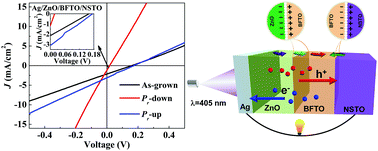Large ferroelectric-polarization-modulated photovoltaic effects in bismuth layered multiferroic/semiconductor heterostructure devices†
Abstract
Ferroelectrics are appealing candidates for photovoltaic applications. In this study, Bi5FeTi3O15 (BFTO) single layer and ZnO/BFTO bilayer films were deposited onto 0.7 wt% Nb-doped SrTiO3 (NSTO) electrically conducting single-crystal substrates to form Ag/BFTO/NSTO and Ag/ZnO/BFTO/NSTO photovoltaic devices. It was found that the insertion of an n-type semiconducting ZnO layer eliminates the built-in electric field between the Ag electrode and the BFTO film and results in the formation of a BFTO/ZnO p–n junction with a built-in electric field whose direction points to the BFTO film. These effects, together with the depolarization field within the BFTO film, provide a favorable energy level alignment for efficient electron extraction. As a result, the short circuit photocurrent density (Jsc) was improved by nearly 50 fold to 2.2 mA cm−2 and the output power density was increased by 15 fold to 0.09 mW cm−2 under ultraviolet light (λ = 405 nm) illumination. Upon the reversal of the ferroelectric polarization direction from downward to upward, the Jsc and the open circuit voltage (Voc) were increased by 2.5 and 4 fold for the Ag/BFTO/NSTO device and by 2.83 and 8.5 fold for the Ag/ZnO/BFTO/NSTO device, respectively. This work provides an effective way for developing efficient ferroelectric and semiconductor based photovoltaic devices.



 Please wait while we load your content...
Please wait while we load your content...